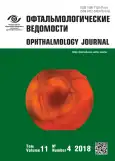New approaches to the treatment of patients with dry age-related macular degeneration and concomitant mild stabilized open-angle glaucoma
- Authors: Sokolov V.O.1, Morozova N.V.1, Florentseva S.S.1, Veselov A.V.1, Morozov M.A.2
-
Affiliations:
- Diagnostic Centre No. 7 (Ophthalmological) for Adults and Children
- I.P. Pavlov State Medical University of St. Petersburg
- Issue: Vol 11, No 4 (2018)
- Pages: 75-83
- Section: Articles
- URL: https://journals.rcsi.science/ov/article/view/11126
- DOI: https://doi.org/10.17816/OV11475-83
- ID: 11126
Cite item
Full Text
Abstract
Relevance. Dystrophic processes in the retina and different types of glaucoma occupy a significant place among ocular disabling conditions. In the present article, the institution’s experience concerning a new approach to treatment of patients with dry age-related macular degeneration and concomitant mild stabilized open-angle glaucoma.
Aim. To clinically estimate the influence of the biologically active dietary supplement “Proluksa” on main visual functions and on the quality of life in patients with dry age-related macular degeneration and concomitant mild stabilized open-angle glaucoma.
Materials and methods. Into the study, 60 patients were included; they were divided into two groups. Patients of the first group received the biologically active dietary supplement “Proluksa”, 2 capsules once a day during three months, and instilled IOP-lowering drops; patients of the second group did not take the biologically active dietary supplement “Proluksa”, they instilled IOP-lowering drops only. Both groups were followed during six months. Three times a standard ophthalmologic examination and instrumental investigations (macular electroretinography, vacuum-compression test with control of visual evoked cortical potentials using a “suction cup”, HRT III of the optic disc, OCT of the macular area) were performed in both groups.
Results. There was a statistically significant positive visual acuity dynamics at stable optimal correction for distance in the group 1; the percentage of relative scotomata decreased in the group 1; vacuum-compression test gave negative results at Visits 1, 2, and 3; the p-100 wave amplitude increased – in the group 1 on the background the biologically active dietary supplement “Proluksa” intake; the a-wave amplitude of the macular ERG increased; according to OCT results, there were no reliable changes in the central retinal area; the optic disc neuroretinal rim width at HRT III remained stable during the whole follow-up period.
Conclusions. According to performed investigations, there were: statistically reliable visual acuity increase at stable optimal correction, statistically significant positive dynamics in retinal photosensitivity, and increase in functional activity of external and internal retinal layers in the macular area. To the third month of preparation intake, patients from the group 1 taking the biologically active dietary supplement “Proluksa” noted the enhancement of image resolution, decrease in visual “defocusing”, better color perception.
Full Text
##article.viewOnOriginalSite##About the authors
Vitaly O. Sokolov
Diagnostic Centre No. 7 (Ophthalmological) for Adults and Children
Author for correspondence.
Email: tavros@mail.ru
MD, PhD, Head of the Centre
Russian Federation, Saint PetersburgNatalya V. Morozova
Diagnostic Centre No. 7 (Ophthalmological) for Adults and Children
Email: tavros@mail.ru
MD, PhD, Deputy Head of the Centre
Russian Federation, Saint PetersburgSvetlana S. Florentseva
Diagnostic Centre No. 7 (Ophthalmological) for Adults and Children
Email: florochka1970@mail.ru
MD, PhD, Day Hospital Ophthalmologist
Russian Federation, Saint PetersburgAnton V. Veselov
Diagnostic Centre No. 7 (Ophthalmological) for Adults and Children
Email: v.a.v83@mail.ru
MD, Special Evaluation Methods Departments, Ophthalmologist
Russian Federation, Saint PetersburgMichail A. Morozov
I.P. Pavlov State Medical University of St. Petersburg
Email: qwertfix@mail.ru
Postgraduate, Department of Ophthalmology
Russian Federation, Saint PetersburgReferences
- Age-related Macular Degeneration. Ed. by F.G. Holz, D. Pauleikhoff, R.F. Spaide, A.C. Bird. Berlin, Heidelberg: Springer-Verlag; 2013. doi: 10.1007/978-3-642-22107-1.
- Нестеров А.П. Первичная открытоугольная глаукома: патогенез и принципы лечения // РМЖ. Клиническая офтальмология. - 2000. - Т. 1. - № 1. - С. 4-5. [Nesterov AP. Pervichnaya otkrytougol’naya glaukoma: patogenez i printsipy lecheniya. RMZh. Klinicheskaya oftal’mologiya. 2000;1(1):4-5. (In Russ.)]
- Соколов В.О., Морозова Н.В., Флоренцева С.С., и др. Опыт применения витаминно-минерального комплекса у пациентов с сухой формой возрастной макулодистрофии // РМЖ. Клиническая офтальмология. - 2016. - Т. 16. - № 4. - С. 211-214. [Sokolov VO, Morozova NV, Florentseva SS. Experience with vitamin and mineral complex in patients with dry type of age-related macular degeneration. RMZh. Klinicheskaya oftal’mologiya. 2016;16(4):211-214. (In Russ.)]
- Лещенко И.А. О системах и правилах определения остроты зрения // Вестник оптометрии. - 2009. - № 3. - C. 54-58. [Leshchenko IA. O sistemakh i pravilakh opredeleniya ostroty zreniya. Vestnik optometrii. 2009;(3):54-58. (In Russ.)]
- Морозова Н.В., Астахов Ю.С., Соколов В.О. Вакуум- компрессионная проба с контролем зрительных вызванных корковых потенциалов для оценки стабилизации глаукомы псевдонормального давления // РМЖ. Клиническая офтальмология. - 2002. - Т. 3. - № 2. - С. 56-58. [Morozova NV, Astakhov YS, Sokolov VO. Vakuum- kompressionnaya proba s kontrolem zritel’nykh vyzvannykh korkovykh potentsialov dlya otsenki stabilizatsii glaukomy psevdonormal’nogo davleniya. RMZh. Klinicheskaya oftal’mologiya. 2002;3(2):56-58. (In Russ.)]
- Шамшинова А.М., Волков В.В. Функциональные методы исследования в офтальмологии. - М., 1998. [Shamshinova AM, Volkov VV. Funktsional’nye metody issledovaniya v oftal’mologii. Moscow; 1998. (In Russ.)]
- Шамшинова А.М. Зрительные вызванные потенциалы. Опыт применения вызванных потенциалов в клинической практике. - М., 2001. [Shamshinova AM. Zritel’nye vyzvannye potentsialy. Opyt primeneniya vyzvannykh potentsialov v klinicheskoy praktike. Moscow; 2001. (In Russ.)]
- Weinreb RN, Liebman J. Медикаментозное лечение глаукомы. 7-й Консенсус Всемирной глаукомной ассоциации. - СПб.: Н-Л, 2014. [Weinreb RN, Liebman J. Medikamentoznoe lechenie glaukomy. 7-y Konsensus Vsemirnoy glaukomnoy assotsiatsii. Saint Petersburg: N-L; 2014. (In Russ.)]
Supplementary files













